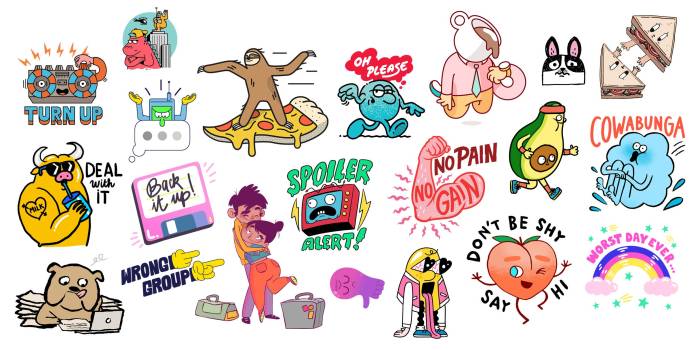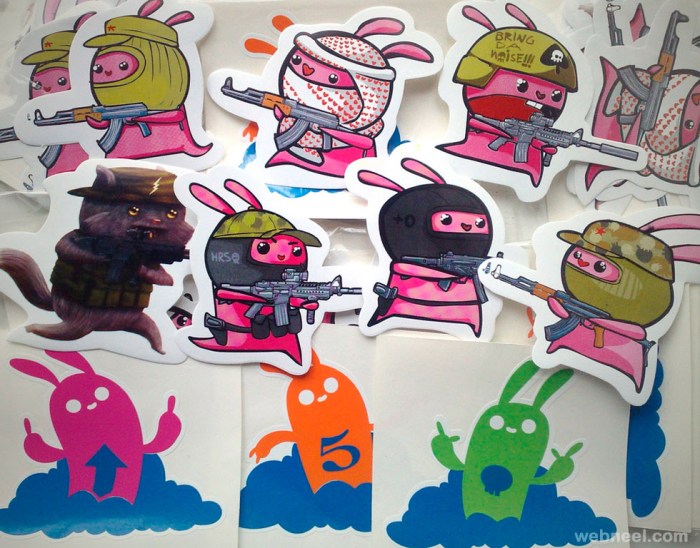Crafting Compelling Sticker Designs: A Guide to Visual Creativity
Embark on a creative journey through the world of sticker design, where visual appeal meets artistic expression to create captivating designs that leave a lasting impression. From color theory to typography, explore the key elements that elevate sticker designs to a whole new level of creativity and engagement.
Discover the techniques and considerations that go into producing unique stickers that reflect brand identity and resonate with audiences. Dive into the realm of sticker design and unleash your creativity in ways you never imagined.
Understanding Sticker Design
When it comes to sticker design, visual appeal plays a crucial role in capturing the attention of the audience. A well-designed sticker can convey a message effectively and leave a lasting impression on the viewer.
Importance of Visual Appeal
Visual appeal is essential in sticker design as it helps in attracting the viewer's attention. Bright colors, unique illustrations, and creative layouts can make a sticker stand out and create a memorable experience for the audience.
Role of Color Theory
Color theory plays a significant role in creating eye-catching stickers. Different colors evoke different emotions and can convey various messages. By understanding color psychology and applying it to sticker design, designers can create visually appealing and impactful stickers.
Significance of Typography
Typography is another crucial element in conveying messages through sticker designs. The choice of font, size, and style can affect the readability and overall aesthetic of the sticker. By using typography effectively, designers can enhance the message and ensure that it is easily understood by the audience.
Elements of a Compelling Sticker Design
When it comes to creating a sticker design that truly stands out, there are several key elements to consider. These elements play a crucial role in making a sticker memorable and visually appealing to the audience. From the choice of shapes and patterns to the balance between text and graphics, each aspect contributes to the overall effectiveness of the design.
Shapes and Patterns in Sticker Design
Using shapes and patterns strategically can greatly enhance the aesthetics of a sticker design. Geometric shapes, such as circles, squares, and triangles, can add structure and visual interest to the design. Additionally, incorporating patterns like stripes, polka dots, or floral motifs can create a unique and eye-catching look.
It is important to consider the overall theme and message of the sticker when selecting shapes and patterns to ensure cohesiveness and impact.
Balance of Text and Graphics
Achieving the right balance between text and graphics is essential for an effective sticker design. The text should be clear, concise, and easy to read, complementing the visuals rather than overpowering them. Graphics, on the other hand, should enhance the message of the sticker and add visual appeal.
Finding the perfect equilibrium between text and graphics will ensure that the design is both visually appealing and communicates its intended message effectively.
Techniques for Creating Unique Sticker Designs
When it comes to creating unique sticker designs, there are several techniques and strategies that can help you stand out. Whether you're brainstorming ideas, incorporating brand identity, or utilizing digital tools, these tips will guide you in developing compelling stickers.
Brainstorming Creative Sticker Ideas
Generating creative ideas for stickers can be a fun and rewarding process. Here are some methods to help spark your creativity:
- Research trends in design and popular themes for inspiration.
- Brainstorm with a team or friends to gather diverse perspectives.
- Create mood boards or Pinterest collages to visually explore ideas.
- Experiment with different color palettes, shapes, and styles to find a unique approach.
Incorporating Brand Identity into Sticker Designs
Your brand's identity is crucial in creating stickers that resonate with your audience. Consider these tips for incorporating brand elements into your designs:
- Use your brand's colors, fonts, and logos to maintain consistency across all marketing materials.
- Highlight key brand messages or slogans to reinforce brand recognition.
- Consider the target audience and design stickers that appeal to their preferences and interests.
- Create a cohesive look that aligns with your brand's overall aesthetic and values.
Using Digital Tools for Designing and Editing Stickers
Digital tools have revolutionized the design process, making it easier than ever to create and edit stickers. Here are some popular tools to consider:
- Adobe Illustrator: Ideal for creating vector-based designs with precision and flexibility.
- Canva: A user-friendly platform with pre-designed templates for quick and easy sticker creation.
- Procreate: Perfect for digital illustration and hand-drawn designs on tablets.
- Photoshop: Great for advanced editing and manipulating images to enhance sticker designs.
Printing and Production Considerations

When it comes to sticker design, the printing and production process plays a crucial role in bringing your creations to life. Here, we will explore the key considerations to keep in mind for a successful printing and production phase.
Selecting the Right Printing Method
Choosing the appropriate printing method is essential to ensure that your stickers are produced with the highest quality and precision. Different types of stickers may require specific printing techniques to achieve the desired results.
- Digital Printing: Ideal for small to medium print runs with intricate designs and vibrant colors.
- Offset Printing: Suitable for larger quantities with precise color matching and consistent quality.
- Silk Screen Printing: Perfect for specialty stickers like those with metallic finishes or special effects.
Choosing Suitable Materials for Durable Stickers
The durability of your stickers largely depends on the materials used during production. Selecting high-quality materials will ensure that your stickers can withstand various conditions and maintain their appearance over time.
- Vinyl: Known for its weather-resistant properties, making it suitable for outdoor use.
- Paper: Ideal for indoor stickers or short-term promotional purposes.
- Laminates: Adding a protective laminate layer can enhance the longevity of your stickers by providing resistance to UV rays, water, and scratches.
Preparing Sticker Designs for Printing and Production
Before sending your designs for printing, it is essential to make sure they are prepared correctly to avoid any issues during production. Properly setting up your artwork files can streamline the printing process and ensure the final product meets your expectations.
- Convert text to Artikels to prevent font substitution issues.
- Set the correct color mode (CMYK for print) to ensure accurate color reproduction.
- Include bleed and safe zones to prevent cutting off important design elements.
Last Recap

In conclusion, sticker design is an art form that combines visual aesthetics with effective communication to convey messages in a unique and engaging way. By understanding the importance of design elements and production considerations, you can create stickers that stand out and leave a lasting impact.
Embrace the world of sticker design and let your creativity shine through every design you create.
Questions Often Asked
How important is color theory in sticker design?
Color theory plays a crucial role in sticker design as it influences emotions, attracts attention, and enhances visual appeal.
What are some tips for balancing text and graphics in sticker design?
To achieve a harmonious design, ensure that text and graphics complement each other without overwhelming the overall composition.
How can brand identity be incorporated into sticker designs effectively?
Integrating brand elements such as logos, colors, and fonts helps establish brand recognition and consistency in sticker designs.
What are the key considerations when selecting materials for durable stickers?
Choosing high-quality, weather-resistant materials is essential for ensuring that stickers remain intact and vibrant for a long time.
Which digital tools are recommended for designing and editing stickers?
Popular tools like Adobe Illustrator, Canva, and Procreate offer versatile features for creating and editing sticker designs with ease.




